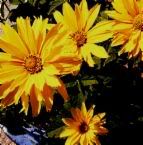

Scientific Name
Heliopsis helianthoides var. scabra
Uses of Smooth Oxeye: Landscaping, Medicinal, Culinary, etc...
Ethnobotanical: It is reported that American Indians made a tea from this plant as a cure for various lung ailments.
Landscaping and Wildlife: Smooth oxeye is a very hardy plant that produces many attractive, yellow flowers throughout the summer. It does well in flower gardens, especially in drier areas, and is relatively maintenance free. It also makes an attractive roadside plant. Insects are attracted to its bright flowers during the summer, and birds are attracted to its seed in the fall.
Required Growing Conditions
Smooth Oxeye is a member of the daisy family, Asteraceae. It is a vigorous, upright, native, perennial forb growing to .4-2 meters in height. The stem is smooth while the leaves are coarsely serrated, having rough, siliceous-based hairs on both surfaces. The stems may be topped with a single, yellow flower, or may branch in to multiple stems with many yellow flowers. The flowers have 10 or more rays and are 3-7 cm in diameter. Unlike sunflowers, each ray may form a fruit that yields a viable seed. The seed is smooth and hard having four sides with fine hairs for wind distribution of seed. It generally does not have a pappus. Though it is a perennial, it is often short-lived.
Distribution: This species is widely distributed across the eastern half of the United States, though it is most often found in the prairie regions of the central United States. It prefers dry soil and open spaces, but will also tolerate moist areas. It can often be found in disturbed areas.
Cultivation and Care
Smooth Oxeye can be established from seed. Planting should occur in the spring, between March and April. Cold, damp stratification for 30 days at 4o C is suggested to improve germination, but is reportedly not necessary. The seed may be drilled on 32-40 inch rows at 4.7 pounds per acre or broadcast at 5.2 pounds per acre. The target rate is 45 PLS/ft when drilled and 15 PLS/ft2 when broadcasted.
General Upkeep and Control
Smooth Oxeye is a very hardy plant with relatively few problems. This species has proven to perform best in the 11.8+ cm (4.6 inches +) precipitation zone and moderate levels of N, P, K are desirable.
Pests and Potential Problems Birds will feed on the seed of Smooth Oxeye in the fall. This may be of concern to the commercial growers. Plant size often inhibits cultivation after 8 weeks when planted in rows.
Cultivars, Improved, and Selected Materials (and area of origin) ‘Midas’ – (Kansas) was released in 1984. It is adapted to the eastern half of Nebraska, Kansas, and Oklahoma extending into western Iowa, Missouri, and Arkansas. This cultivar is tolerant of dry conditions, though adequate moisture is necessary for proper growth. Midas is readily available through commercial sources. Central Iowa Germplasm – (Iowa) was released in 1996. It is source – identified material that is especially adapted to central Iowa. It is commercially available. Northern and Southern Iowa Germplasms – (Iowa) were released in 1997, and are also source - identified materials that are especially adapted to those regions in Iowa. They are also commercially available.





1 comments:
pemainayam.net said...
sabung ayam taji